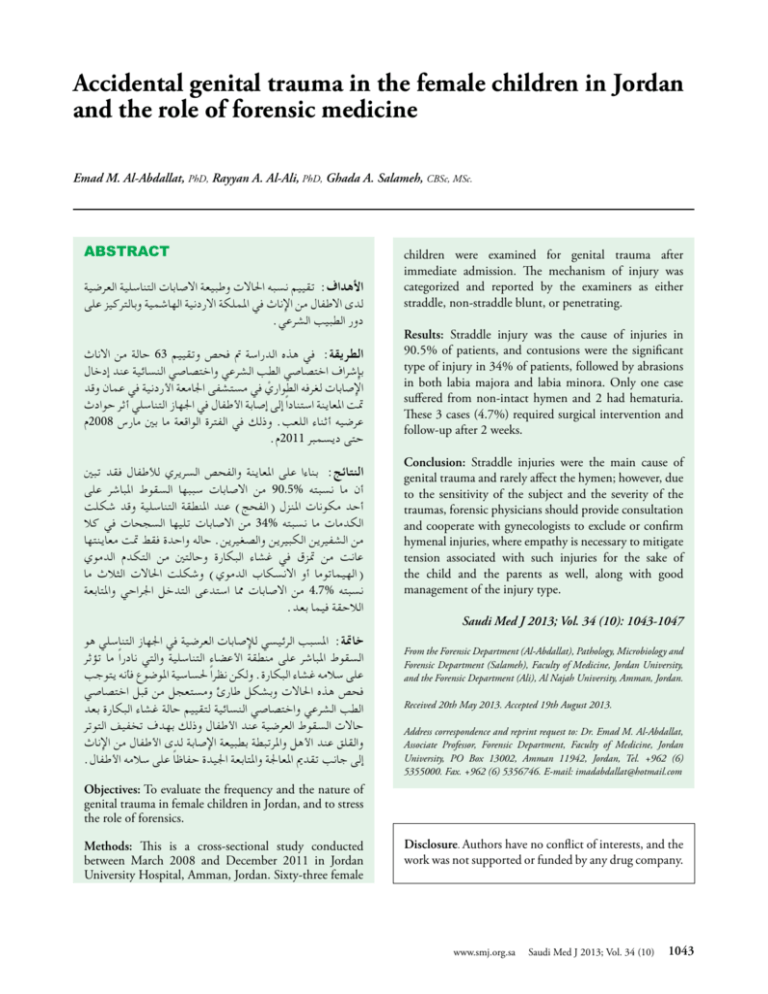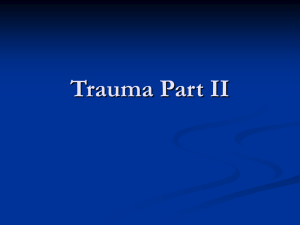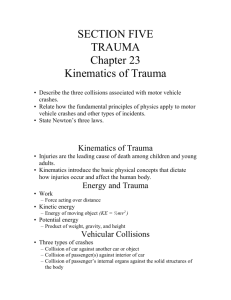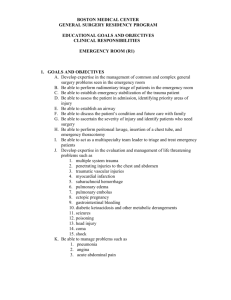this PDF file - Saudi Medical Journal
advertisement

Accidental genital trauma in the female children in Jordan and the role of forensic medicine Emad M. Al-Abdallat, PhD, Rayyan A. Al-Ali, PhD, Ghada A. Salameh, CBSc, MSc. ABSTRACT تقييم نسبه احلاالت وطبيعة االصابات التناسلية العرضية:األهداف لدى االطفال من اإلناث في اململكة االردنية الهاشمية وبالتركيز على .دور الطبيب الشرعي حالة من االناث63 في هذه الدراسة مت فحص وتقييم:الطريقة بإشراف اختصاصي الطب الشرعي واختصاصي النسائية عند إدخال الطواري في مستشفى اجلامعة األردنية في عمان وقد اإلصابات لغرفه ْ متت املعاينة استناداً إلى إصابة األطفال في اجلهاز التناسلي أثر حوادث م2008 وذلك في الفترة الواقعة ما بني مارس.عرضيه أثناء اللعب .م2011 حتى ديسمبر بناءا على املعاينة والفحص السريري لألطفال فقد تبني:النتائج من االصابات سببها السقوط املباشر على90.5% أن ما نسبته أحد مكونات املنزل (الفحج) عند املنطقة التناسلية وقد شكلت من االصابات تليها السجحات في كال34% الكدمات ما نسبته حاله واحدة فقط متت معاينتها.من الشفيرين الكبيرين والصغيرين عانت من متزق في غشاء البكارة وحالتني من التكدم الدموي (الهيماتوما أو االنسكاب الدموي) وشكلت احلاالت الثالث ما من االصابات مما استدعى التدخل اجلراحي واملتابعة4.7% نسبته .الالحقة فيما بعد املسبب الرئيسي لإلصابات العرضية في اجلهاز التناسلي هو:خامتة السقوط املباشر على منطقة األعضاء التناسلية والتي نادراً ما تؤثر ولكن نظراً حلساسية املوضوع فأنه يتوجب.على سالمه غشاء البكارة فحص هذه احلاالت وبشكل طارئ ومستعجل من قبل اختصاصي الطب الشرعي واختصاصي النسائية لتقييم حالة غشاء البكارة بعد حاالت السقوط العرضية عند األطفال وذلك بهدف تخفيف التوتر والقلق عند األهل واملرتبطة بطبيعة اإلصابة لدى األطفال من اإلناث .إلى جانب تقدمي املعاجلة واملتابعة اجليدة حفاظ ًا على سالمه األطفال children were examined for genital trauma after immediate admission. The mechanism of injury was categorized and reported by the examiners as either straddle, non-straddle blunt, or penetrating. Results: Straddle injury was the cause of injuries in 90.5% of patients, and contusions were the significant type of injury in 34% of patients, followed by abrasions in both labia majora and labia minora. Only one case suffered from non-intact hymen and 2 had hematuria. These 3 cases (4.7%) required surgical intervention and follow-up after 2 weeks. Conclusion: Straddle injuries were the main cause of genital trauma and rarely affect the hymen; however, due to the sensitivity of the subject and the severity of the traumas, forensic physicians should provide consultation and cooperate with gynecologists to exclude or confirm hymenal injuries, where empathy is necessary to mitigate tension associated with such injuries for the sake of the child and the parents as well, along with good management of the injury type. Saudi Med J 2013; Vol. 34 (10): 1043-1047 From the Forensic Department (Al-Abdallat), Pathology, Microbiology and Forensic Department (Salameh), Faculty of Medicine, Jordan University, and the Forensic Department (Ali), Al Najah University, Amman, Jordan. Received 20th May 2013. Accepted 19th August 2013. Address correspondence and reprint request to: Dr. Emad M. Al-Abdallat, Associate Professor, Forensic Department, Faculty of Medicine, Jordan University, PO Box 13002, Amman 11942, Jordan, Tel. +962 (6) 5355000. Fax. +962 (6) 5356746. E-mail: imadabdallat@hotmail.com Objectives: To evaluate the frequency and the nature of genital trauma in female children in Jordan, and to stress the role of forensics. Methods: This is a cross-sectional study conducted between March 2008 and December 2011 in Jordan University Hospital, Amman, Jordan. Sixty-three female Disclosure. Authors have no conflict of interests, and the work was not supported or funded by any drug company. www.smj.org.sa Saudi Med J 2013; Vol. 34 (10) 1043 Genital trauma in Jordanian female children … Al-Abdallat et al T rauma of the genitalia has a special concern, especially, in the Muslim world, and ironically not because of its severity, rather than conservancy of virginity in women of all ages, which is, manifold through cultural pressure and attitude towards this issue. However, these concerns are exaggerated in pediatric patients, where genital trauma can be an accidental injury or from intentional assault.1 And importantly is the site of the injury which would cause anxiety to the parents about future gynecological problems as well as to their sexual development.2 Moreover, collected data on genital trauma in young girls majority focused on non-accidental trauma’s related etiologies and there is an obvious scarcity in strong description of the injury pattern seen in accidental genital trauma.3,4 As a general rule non-sexual, non-obstetric gynecologic injuries in young girls can be roughly characterized based on the mechanism of injury into 3 types; straddle injuries, non-straddle blunt injuries, and penetrating injury.3 Evaluation of genitalia of the female child requires different techniques and approaches other than what is used with adults, and the examination should be thorough and described in details, where appearance, location, and size should be documented and photographed and it is essential to understand that physical findings can mimic signs of trauma or sexual abuse; therefore, careful examination findings are of importance in this category of patients.5,6 Moreover, the features that distinguish accidental injuries from abuse injuries are strongly indicated when the patient presents immediately following the injury and the history is compatible with the type of injury seen, moreover, accidental injuries rarely affect the hymen, though, penetrating by a sharp object wither accidental or intentional may cause hymenal or even vaginal injury with minimal or no disruption of the hymenal edge, an added feature is the extent of injury to adjacent tissues. Still, hymenal injuries are seldom accidental and should be reported to the authorities for further investigation on the scene of accident.7 Genital injuries mostly heal quickly and without residua, and hymen healing usually does not leave scar, but vascular changes may occur to the surrounding tissues.8 The aim of this article was to evaluate the percentage of genital trauma in females children in Jordan especially those who were admitted to one of the biggest hospitals in Jordan and the nature of these injuries and to highlights on the role of forensic physicians in the differential diagnosis of genital injury and long-term physical and psychological management to preserve the rights of both the girls and caregivers in safeguarding them from cultural pressure. This subject will open the door to better management of such 1044 Saudi Med J 2013; Vol. 34 (10) www.smj.org.sa cases when admitted to hospital when excluding abuse injuries, where forensic physicians and gynecologists can deal with relieving parents and calming them on the safety of their girls and future consequences and to address on the fact that accidents rarely causes hymenal injuries based on the forensics differential diagnosis conducted. Methods. This is a cross-sectional study conducted between March 2008 and December 2011 in Jordan University Hospital, Amman, Jordan. Sixty-three female children were examine for genital trauma after immediate admission. The age of the female children ranged from 6 months-14 years old and the average was 5.7 years old. The majority of the injuries resulted from activities inside the home of the caregivers while playing and ranging from falling on the edge of a bed, bathtub, and fell from the stairs. The design was reviewed and approved by the Institutional Review Board, Ethics Committee of Jordan University Hospital (J IRB/2013/31). Moreover, consents, protocol used in examination, and reporting, were according to the Helsinki declaration for human experimentation. The inclusion criteria was female children of eligible ages admitted to JUH emergency room showing genital injury. A careful history and physical examination was performed and following JUH protocol dealing with infants or adolescents having genital injuries. The history must correlate with physical findings to confirm non-sexual trauma, and the gynecologist should refer to the hospital admissions log-book and police log-book for sexual assault history. Careful questioning on the caregiver status was included and majority of them were ranked as of middle socioeconomic status and pay a great deal to the conservancy of the child hymen and the effect on their sexual development. Patients logs were reviewed for time of admission, complain, time of injury, and mechanism of injury; and were examined by a gynecologist and in the presence of a forensic physician. Provided that sexual abuse was excluded in all cases, due to the nature of the injury after differential diagnosis, the presence of the parents and the immediate show up in the emergency room and the apparent anxiety of the caregivers who were all the parents. All female children with vaginal traumas came within a short time of the trauma to the emergency room and the main concern of the family was to be sure about the hymen. These cases seen in the emergency room by the gynecologist and the gynecologist dealt with the injuries and consulted the forensic physician regarding the hymen and if he is not available they call Genital trauma in Jordanian female children … Al-Abdallat et al him to come to see the cases, all these cases were seen by the main author (consultant forensic medicine) after taking the informed consent from the parents, external inspection is carried out (gynecological position, examiners pulled the labia major outward and down to see the hymen), and most of the cases were enough to identify the hymen status. Some cases, either because of the child is irritable and not cooperative or because of pain or hematoma, these cases either are re-evaluated in the forensic clinic by external inspection or with colposcopy. Rare cases with severe injuries which needed gynecological procedures in the theater room the examination by forensic physician was also carried out in the operating room which was easier to be carried out. Genital examination findings were recorded in details, including exact injury location, type of injury, severity, size, and even negative findings. Forensic reports of the hymen was also recorded and a copy of files were save for the family and for the hospital file. The mechanism of injury was categorized and reported by the examiners as straddle, non-straddle blunt, or penetrating. The distinction between injuries based on the following; injuries that result from a falling on object between legs a subsequent injury is considered straddle while the non straddle blunt genital injury is not related to a fall but as a result of struck by an object. Results. Injuries in female patients admitted to the hospital were, mostly, due to falling on blunt objects in the house of the caregivers. Moreover, falling on or from the furniture on blunt edges was the reason of genital injury in 33% of the cases (Table 1). In categorizing the main mechanisms of injury, 90.5% of the genital injury was categorized under straddle injury (Table 2). These injuries ranged from redness, bruising, abrasions to small lacerations in the genitalia and most of these injuries where concentrated in both labia majora and labia minora (Table 3). The most prominent injuries were contusions and bruising in 55% of the Table 1 - Reported mechanism and object that caused injury of 63 female girls. Mechanism and object Fall during playing Fall on a furniture Fall on miscellaneous house hold object Fall in the bathroom on blunt edges Fall from stairs or ladders Fall on wood or iron sticks or pipes Car hit Fall from bicycle Other n 8 21 8 6 6 5 1 1 7 (%) (13.0) (33.0) (13.0) (9.5) (9.5) (8.0) (1.5) (1.5) (11.0) patients, followed by abrasions with 9.5%, hematomas and redness with 4.7% (Table 4). Only one case had lacerated hymen and 2 patients with hematomas; the 3 required surgical intervention (4.7%), the 3 cases required intervention under anesthesia and then reevaluation with professional follow up in the same hospital for 2 weeks. All cases reviewed and diagnosed were under the supervision of both a gynecologist and the forensic physician. Overall, most of the injuries were minor and most of the patients and their parents received gynecological consultation. This study is a descriptive study and only percentage of injuries was required. Discussion. Collectively, straddle injuries are the most accidental female genital trauma and mostly the etiology of genital trauma in girls under the age of 14 years. This type of trauma typically results when the soft tissues of the vulva are compressed between an object Table 2 - Mechanism of injury in main categories in 63 female girls. Categorizing mechanism of injury Straddle injury Non straddle blunt Penetrating n 57 1 5 (%) (90.5) (1.5) (8.0) Table 3 - Summary of examination findings on sites of injury in 63 female girls. Injury site n (%) Labia majora 14 (22.0) Labia minora 24 (38.0) Labia majora and minora 5 (8.0) Fourchette 4 (6.0) Labia minora and fourchette 2 (3.0) Opening of the urethra 1 (1.5) Clitoris 1 (1.5) *Hymen 1 (1.5) †No Injuries 15 (24.0) *All patients had intact hymen except for one patient. †15 admitted female children had normal examination findings, with no serious injuries. Table 4 - Type of injury. Type of injury Laceration Abrasion Contusion or bruising Hematoma Redness www.smj.org.sa n (%) 4 (6.0) 6 (9.5) 35 (55.0) 3 (4.7) 3 (4.7) Saudi Med J 2013; Vol. 34 (10) 1045 Genital trauma in Jordanian female children … Al-Abdallat et al and the underlying bones of the pelvis; these injuries include falling on a frame of a bicycle, ladder rungs, bath tubs and play ground equipment, or piece of furniture like chairs arms.2,5 Quite frequently, they are questioned as a sexual abuse cases. Straddle injuries, usually, involve the external genitalia, vestibule, perineum, or posterior fourchette. Injuries extending outside the genitalia and anal area are uncommon.2 In this survey, blood was consistent with each injury in most cases and even in minor injuries, the patient can bleed excessively because the external genitalia have a rich blood supply and that is an enough reason for escalated anxiety in parents and most importantly the patient. Penetrating injuries, however, are defined as a piercing injury of the genitourinary or arorectal tissues. This type of injuries usually are more extensive and involve more commonly trauma to the hymen and vagina, also visceral injury is possible even in the absence of significant bleeding and symptoms. Additionally, hematuria, vaginal bleeding, vaginal discharge pain or rectal bleeding is current with penetration injuries.3 The hymen, nevertheless, may not injured during a fall astride because it is located relatively internally and well protected by labia, it is extremely unlikely to be injured during a fall stride, but in very rare circumstances accidental penetrative trauma has been reported to cause injury to the vaginal vestibule and hymen. In unique rare cases, a crushing genital injury associated with a fall astride had damaged the hymen, but this type of event is unexpected and rare.9 These rare cases could be due to the fact that in the prepubertal child, unestrogenized tissue deficits distinsibility and is more fragile, which can in rare cases of blunt vehicle trauma result in vaginal lacerations as a result of extreme pelvic compressive forces.10 In urogenital trauma, where sexual abuse might be questioned, it is exceedingly essential to be able to correlate mechanism of injury to the expected examination findings.3,8 Essentially, what makes the difference is the interpretation of examination findings, which may reduce incorrect attribution of normal findings to trauma or sexual abuse. The history given by the child, parents or caregivers, and witnesses are the most important elements in the initial assessment and the one conducting the assessment.9 Unfortunately, pediatricians often lack training in examination techniques, determination of normal findings and gynecologic pathology of infants and prepubertal child.12 And gynecological practitioners usually face challenge when conducting genital examination, in particular, when the aim is to provide comfort away from anxiety to the caregivers and the female child. 1046 Saudi Med J 2013; Vol. 34 (10) www.smj.org.sa And to understand what is normal and what is not, so that the gynecologist exactly knows what he is looking at, then to estimate the severity of the case.9 Furthermore, since accidental and intentional genital trauma may result in long term physical and psychological sequel for girls, a well informed and trained health care provider as well as a forensic physician can recuperate each patients quality of life by the competent initial medical care and supportive follow up.13 The management of such cases should concentrate on stabilizing the patient, where the preparation of the child is of paramount concern, comforting the caregivers and once the patient is stabilized, the focus should be drifted to promptly recognize, diagnose and repair of the genital area. After all, one of the aspects of forensic medicine in accidental trauma is to safeguard the intact hymen and protect pediatrician or gynecologists from future allegations when interventions are required to protect the hymen.14 Surgical interventions in pediatric or adolescent genital trauma are low; yet, the examination of children and adolescents with genital injuries must be thorough.2 Evaluation of the external genitalia in the pediatric and adolescent population requires different technique and approach than used in adults. It is essential to have an understanding for the variations in the normal anogenital anatomy.5 An approach to injured child should follow the regular assessment of vital signs; airway, breathing, circulations and the source of trauma.5,13 However, in cases of genital trauma the severity of the injury and the amount of bleeding determine where and how the examination should take place.4 The factors that significantly associated with gynecologic and operative management include older age, transfer to emergency room, and shorter time to presentation, laceration type injury, hymenal injury and larger size injuries. Straddle injuries, moreover, are less likely to be taken to the operating room. In our study, 90.5% of the injury cases were straddles injuries, which is nearly similar to the percentage in a retrospective review of unintentional genital trauma, the study evaluated 105 girls and 81% of them suffered from straddle injuries.2 Study limitations. Lack of psychological review of patients after physical examination due to caregiving pressures and concern. Data collected on the patients and the mechanism of injury relied on parent’s direct reported information only. However, we think our findings can help future research on better interpretation of genital accidental injuries and categorizing them dealing with this group of patients. Where allocating injury surveillance registry can potentially help Genital trauma in Jordanian female children … Al-Abdallat et al gynecologists and forensic physician in excluding sexual abuse traumas and differentiating sexual traumas from straddle injuries. In conclusion, the extent of the genital injuries in the female children, where we excluded sexual abuse upon significant findings, some cases needed further investigation in the presence of a gynecologist, either, to repair the injury, or to reassure the examination. It was necessary that a forensic physician and a gynecologist to attend in the operation room to examine the hymen before and after the management. Additionally, as recommended some cases were reexamined after 2 weeks of the first admission. Patients with straddle injuries appears to be with fewer risk and to have substantial injuries and most cases require no surgical intervention when associated with patients with non-straddle blunt or penetrating trauma, which are more likely to have injuries beyond the labia and require operative intervention. We also conclude that accidental genital trauma injuries are concentrated mostly to the labia and expectantly can be managed. Moreover, these injuries rarely affect the hymen, but can occur in extreme or direct traumas. Nonetheless, and decisively sexual abuse should be excluded from the beginning by the confirmation of the forensic physician after delivering a written report to the institution and the parents. Conclusively, genital injuries should be dealt with care and empathy in the presence of forensic physician to reduce the social burden and family tension in that subject in particular, especially, in the conservative societies where social, religious and traditional believes about the sexual traumas and their consequences are overestimated. And therefore, the ultimate goal in the intervention of such severe traumas should provide suitable strategy to relief pain and provide direct physiological relief for the patients and caregivers as well as to provide proper follow-ups in the surgical room and in the clinic afterwards. References 1. Benjamins LJ. Genital trauma in pediatric and adolescent females. J Pediatr Adolesc Gynecol 2009; 22: 129-133. 2. Spitzer RF, Kives S, Caccia N, Ornstein M, Goia C, Allen L. Retrospective review of unintentional female genital trauma at a pediatric referral center. Pediatr Emerg Care 2008; 24 Suppl 12: 831-835. 3. Iqbal CW, Jrebi NY, Zielinski MD, Benavente-Chenhalls LA, Cullinane, DC, Zietlow SP, et al. Patterns of accidental genital trauma in young girls and indications for operative management. J Pediatr Surg 2012; 45: 930-933. 4. Fette A, Horte LG. Straddle injury in girls. A pilot study testing potential for an injury surveillance registry. Open Pediatr Med J 2009; 3: 21-25. 5. Merritt DF. Genital trauma in the pediatric and adolescent female. Obstet Gynecol Clin North Am 2009; 36: 85-98. 6. Jones JG, Worthington T. Genital and anal injuries requiring surgical repair in females less than 21 years of age. J Pediatr Adolesc Gynecol 2008; 21: 207-211. 7. Muram D, Levitt CJ, Fraiser LD, Simmons KJ, Merritt DF. Genital Injuries. J Pediatr Adolesc Gynecol 2003; 16: 149-155. 8. Pillai M. Genital findings in prepubertal girls: what can be concluded from an examination? J Pediatr Adolesc Gynecol 2008; 21: 177-185. 9. Smith A. The prepubertal Hymen. Aust Fam Physician 2011; 40 Suppl 11: 873-875. 10. Gabriel NM, Clayton M, Starling SP. Vaginal laceration as a result of blunt vehicular trauma. J Pediatr Adolesc Gynecol 2009; 22: 166-168. 11. Merritt DF. Vulvar and genital trauma in pediatric and adolescent gynecology. Curr Opin Obstet Gynecol 2004; 16: 371-381. 12. Sugar NF, Graham EA. Common gynecological problems in prepubertal Girls. Pediatr Rev 2006; 27 Suppl 6: 213-222. 13. Merritt DF. Genital trauma in the prepubertal girls and Adolescents. Curr Opin Obstet Gynecol 2011; 23: 307-314. 14. Aber-Rahman HA. Hymen care for unmarried Muslim females: role of the forensic consultant in gynecology interventions. East Mediterr Health J 2009; 15 Suppl 4: 861-867. New Peer Reviewers Join our team of expert peer reviewers for the Saudi Medical Journal by sending an enquiry and summarized CV to info@psmmc.med.sa Note that SMJ reviewers, whose reviews are returned on time and are judged satisfactory by the Editors, may receive 1 CME credit per review, with a maximum of 5 credits per year, from the Saudi Council for Health Specialties. www.smj.org.sa Saudi Med J 2013; Vol. 34 (10) 1047








